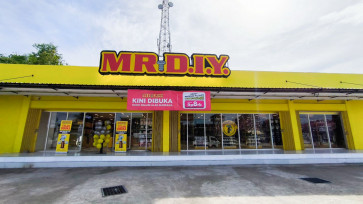Popular Reads
Top Results
Can't find what you're looking for?
View all search resultsPopular Reads
Top Results
Can't find what you're looking for?
View all search resultsThe buzz around Vespas
The humble Vespa, first designed and produced as cheap form of transport in Italy after World War II, has 50 years on become a fashion icon for the world's bright young things
Change text size
Gift Premium Articles
to Anyone
The humble Vespa, first designed and produced as cheap form of transport in Italy after World War II, has 50 years on become a fashion icon for the world's bright young things.
Variations, such as the added blinkers on this 1960’s Vespa, bring the wasp-like motorcycles in line with modern vehicle laws. (JP/J. B. Djwan)
In its heyday of the 1950's and *60's, 15 million of the two-stroke scooters were exported around the world -- millions of them landing like a plague of wasps on Indonesian soil.
In fact, they are wasps. When manufacturer Enrico Piaggio, from the aeronautical building Piaggio family, first saw the prototype in 1946 he laughed and said "Sembra una vespa!" ("It resembles a wasp!") due to the revolutionary scooter's broad backside.
And it is that wasp-like shape that has endeared people around the world to Vespas decade after decade.
Today, enterprising Indonesians are scouring the back blocks of the country in search of old models, restoring them and exporting them to Europe, America, Britain and Australia.
Amalia, who goes by one name only, works for AJ's Vespa Shop in Kuta. The business exports more than 100 restored Vespas a year and with the growing Vespa fashion trend that number is expected to rise.
"We even export back to Italy. It's like sending them back to the factory," says Amalia, who does not ride a Vespa.
"I am a bit bored with them. When I go to sleep at night I see Vespas, when I wake up I see Vespas and when I come to work, only Vespas!" Amalia laughs.
She points out prices for the little wasp have grown along with their icon status. The older the scooter the more expensive, with 1960 to 1970 fully restored models selling for at least Rp 10 million (US$800).
However, by the time they hit the road in countries like Australia you can expect to pay more than double that. One Vespa for sale in England was for sale online at almost 4,000 British pounds (US$6,180).
A little bit of homework -- and some serious hunting across Java -- can net you a ripper old Vespa for as little as Rp 2 million. Likewise, a search of the for sale advertisements online or in newspapers may turn up a good scooter in running condition for around Rp 3 million -- even in Bali.
Most of the Vespas at AJ's are shipped down from Java, Amalia said, but they are growing harder to find even there.
"A lot of people are now shipping Vespas to Bali, so there is a lot of competition," she said.
It is the high fashion element and inflated cost that Australian architecture student and Vespa fan, Ying-lan Dann, finds ironic.
"It seems curious that Vespas were designed and built for the proletariat as a cheap form of transport, but today they are being remarketed for design audiences," she said from Aneka Vespers in Kuta.
Ying-lan had just discovered a very rare Vespa scooter cousin, a 1952 Lambretta, at the shop and was clearly falling in love with the immaculately restored machine.
Aneka is the largest Vespa spare parts dealer in Bali and home to dozens of Vespas in various states of repair.
Aneka Vespers owner, Beby, with some of the Vespas he has restored. (JP/J. B. Djwan)
Owner of Aneka, 50 year old former Jakartan, Beby, has been mad about Vespas for the past two decades. He is clearly more at ease with scooters than talking with visitors, until the special variations on his Vespas are complimented.
One 1960's Vespa has an airplane hood ornament on the front wheel cover, a tribute to Piaggio's aeronautical ancestry. The silver plane looks like something from the 1930's art deco period and sets the Vespa apart from others, as do the spare wheels reinvented as back supports for pillion passengers.
"These are my variation designs," said Beby with a delighted grin.
While Beby's variations are subtle, up the hill in Ubud, Vespas are being chopped up, welded, reformed and revisited, ending up like Mad Max machinery.
At Jingga Motor, a cramped Vespa repair shop on the outskirts of Ubud, dozens of Vespa bits lay stacked in piles of broken bodies, clapped out clutch plates, carburetors and cable.
Some of these will be recycled and rebuilt in their original wasp form; others will morph into black ant-like beasts that hug the road, their riders crawling just centimeters from the tar.
"I have five Vespas. This one is a 1970's model that I have toured to Java with many times," says Jingga mechanic Gusti Mataram, patting a red Vespa and sidecar on its rounded rump.
The buzz around Vespas has been there since the first day they rolled off the Piaggio assembly line in Italy. Today, there are Vespa clubs in many countries, including Indonesia, which will host an international Vespa rally in Ubud next month.
Vespa enthusiasts from Malaysia and Australia are already booked to join their Vespa brethren at the December rally, where hundreds of the wasps are expected to swarm.











